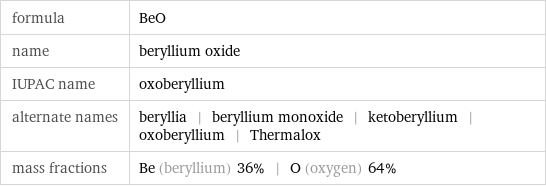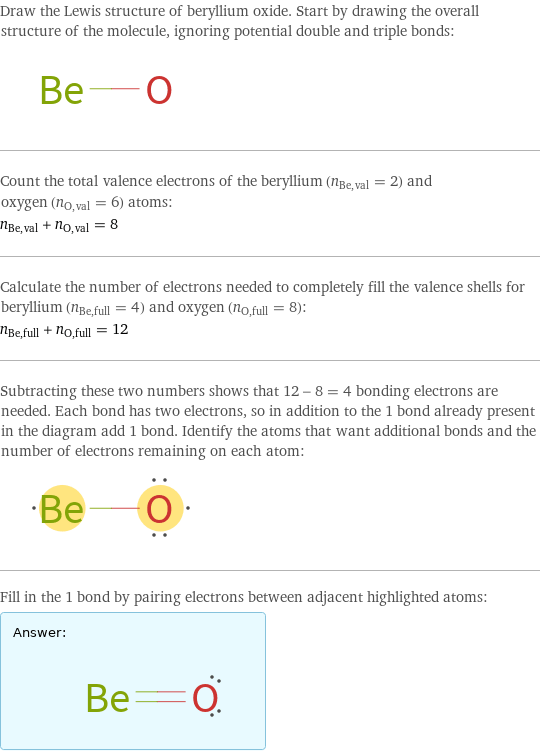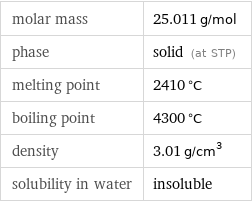Input interpretation

beryllium oxide
Chemical names and formulas

formula | BeO name | beryllium oxide IUPAC name | oxoberyllium alternate names | beryllia | beryllium monoxide | ketoberyllium | oxoberyllium | Thermalox mass fractions | Be (beryllium) 36% | O (oxygen) 64%
Lewis structure

Draw the Lewis structure of beryllium oxide. Start by drawing the overall structure of the molecule, ignoring potential double and triple bonds: Count the total valence electrons of the beryllium (n_Be, val = 2) and oxygen (n_O, val = 6) atoms: n_Be, val + n_O, val = 8 Calculate the number of electrons needed to completely fill the valence shells for beryllium (n_Be, full = 4) and oxygen (n_O, full = 8): n_Be, full + n_O, full = 12 Subtracting these two numbers shows that 12 - 8 = 4 bonding electrons are needed. Each bond has two electrons, so in addition to the 1 bond already present in the diagram add 1 bond. Identify the atoms that want additional bonds and the number of electrons remaining on each atom: Fill in the 1 bond by pairing electrons between adjacent highlighted atoms: Answer: | |
Basic properties

molar mass | 25.011 g/mol phase | solid (at STP) melting point | 2410 °C boiling point | 4300 °C density | 3.01 g/cm^3 solubility in water | insoluble
Units

Solid properties (at STP)

density | 3.01 g/cm^3
Units

Thermodynamic properties

specific heat capacity c_p | solid | 1.024 J/(g K) molar heat capacity c_p | solid | 25.6 J/(mol K) specific free energy of formation Δ_fG° | solid | -23.19 kJ/g molar free energy of formation Δ_fG° | solid | -580.1 kJ/mol specific heat of formation Δ_fH° | solid | -24.37 kJ/g molar heat of formation Δ_fH° | solid | -609.4 kJ/mol specific entropy S° | solid | 0.5597 J/(g K) molar entropy S° | solid | 14 J/(mol K) molar heat of fusion | 86 kJ/mol | specific heat of fusion | 3.4 kJ/g | (at STP)
Chemical identifiers
![CAS number | 1304-56-9 PubChem CID number | 14775 PubChem SID number | 24852117 SMILES identifier | [Be]=O InChI identifier | InChI=1/Be.O/rBeO/c1-2 RTECS number | DS4025000 MDL number | MFCD00003457](../image_source/25f9a536ae0e5bda060d6fa0e4040dfb.png)
CAS number | 1304-56-9 PubChem CID number | 14775 PubChem SID number | 24852117 SMILES identifier | [Be]=O InChI identifier | InChI=1/Be.O/rBeO/c1-2 RTECS number | DS4025000 MDL number | MFCD00003457
Toxicity properties

RTECS classes | tumorigen | mutagen | reproductive effector